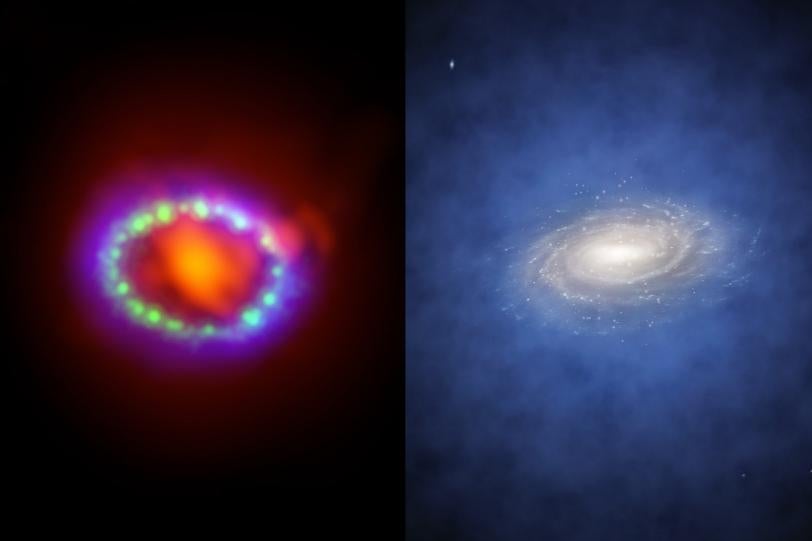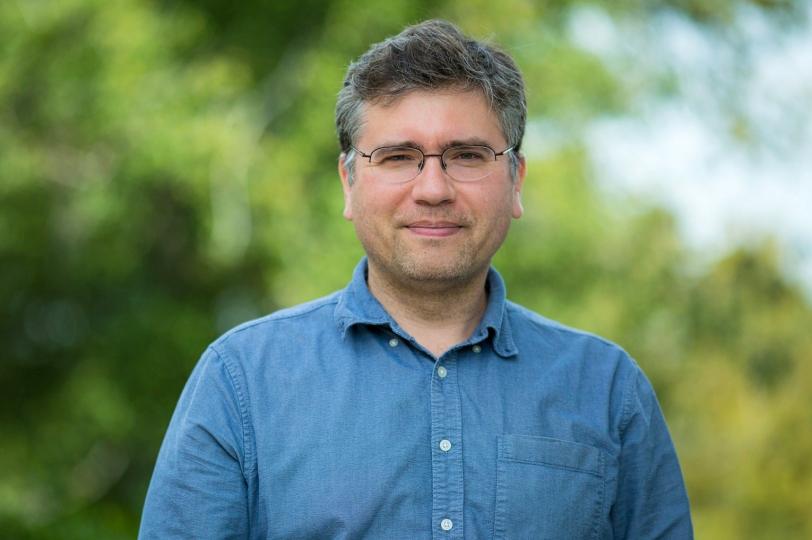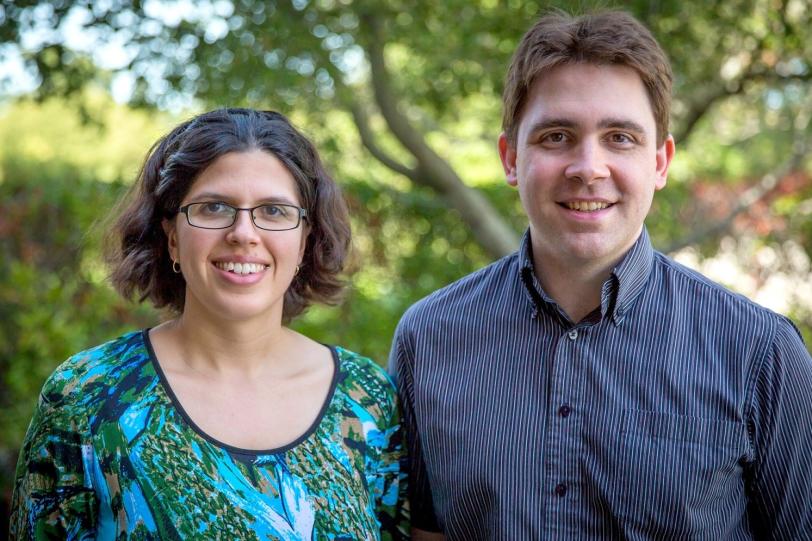Physicist Trio Amplifies SLAC Research on Mysterious Forms of Matter
Elusive Neutrinos and Hypothetical ‘Dark Sector’ Particles Could Hold Answers to Cosmic Mysteries
All material things appear to be made of elementary particles that are held together by fundamental forces. But what are their exact properties? How do they affect how our universe looks and changes? And are there particles and forces that we don’t know of yet?
Questions with cosmic implications like these drive many of the scientific efforts at the Department of Energy’s SLAC National Accelerator Laboratory. Three distinguished particle physicists have joined the lab over the past months to pursue research on two particularly mysterious forms of matter: neutrinos and dark matter.
Neutrinos, which are abundantly produced in nuclear reactions, are among the most common types of particles in the universe. Although they were discovered 60 years ago, their basic properties puzzle scientists to this date.
Alexander Friedland, a senior staff scientist in SLAC’s Elementary Particle Physics Theory Group, works on techniques that pave the way for future analyses of neutrino bursts from supernovae. Studying the details of these powerful star explosions helps scientists understand how dying stars spit out chemical elements into deep space.
Natalia Toro and Philip Schuster, associate professors of particle physics and astrophysics at SLAC, look for something even more enigmatic. They develop ideas for experiments that search for hidden particles and forces linked to dark matter, an invisible form of matter that is five times more prevalent than ordinary matter.
“Alex, Natalia and Philip are significant additions to the SLAC family, whose outstanding expertise tremendously strengthens our research in areas of national priority,” says JoAnne Hewett, head of the lab’s Elementary Particle Physics Division. Neutrino physics and dark matter research are among the five science drivers for U.S. particle physics identified in 2014 by the Particle Physics Project Prioritization Panel. Neutrino research also ranked high in the 2015 long-range plan for nuclear science issued by the Nuclear Science Advisory Committee.

Neutrinos from Across the Country and from Across the Galaxy
One of the major neutrino projects with SLAC involvement is the international Deep Underground Neutrino Experiment (DUNE) at the planned Long-Baseline Neutrino Facility (LBNF) – the world's flagship neutrino experiment for the coming decade and beyond. Researchers will send a neutrino beam produced at Fermi National Accelerator Laboratory in Illinois to the Sanford Underground Facility in South Dakota. After travelling 800 miles through the Earth, some of these neutrinos will be detected by the DUNE Far Detector, which will eventually consist of four 10,000-ton modules of liquid argon located 4,850 feet underground.
The ultrasensitive neutrino “eye” will measure how the three known types of neutrinos, called flavors, and their antiparticles morph from one into another during their underground journey. This study will provide crucial insights into the relative masses of neutrino flavors and the possibility that antineutrinos behave differently than neutrinos, which could potentially help explain why the universe is made of matter rather than antimatter. The experiment will also follow up on hints that there may be more than three neutrino flavors in nature.
"To help DUNE reach its full potential, my work addresses a number of fundamental questions," says Friedland, SLAC's first neutrino theorist, who joined the lab in the summer of 2015. "How can additional neutrinos be incorporated into our theories? Are there also additional forces? Is there a link between neutrinos and dark matter? How do neutrinos interact with atomic nuclei in the detector material?"
In addition to neutrinos from Fermilab, DUNE will also be able to detect very brief neutrino bursts from supernovae – powerful explosions of massive stars with cores that can no longer resist gravity and collapse to form dense neutron stars.
“Such a burst should be an exquisite probe of neutrino properties,” Friedland says. “Our goal is to understand how to read the signal and optimize our detector for it.”
Supernova explosions are important events in the universe. They inject chemical elements, synthesized inside stars over their lifetimes, into space, including crucial elements of life. Friedland hopes that DUNE’s data will reveal never-before-seen details in the related neutrino bursts that could open a window into the processes inside dying stars.
“Our calculations show that those neutrino signals have a certain time structure that is linked to what’s going on in the star,” he says. “Measuring these minute details could help us understand the different stages of a supernova, from the collapse of the star’s core to the outward propagation of powerful shock waves.”
Such detailed analysis can only be done by looking at neutrinos. Unlike other particles, which frequently interact with their surroundings on their way out of the star and therefore carry the imprint of this complicated environment, neutrinos stream out nearly undisturbed and deliver direct information about the processes in which they were set free.
“Supernovae go off without warning, and detectable ones don’t occur very often,” says Friedland, who co-leads the DUNE supernova working group. “Although the next supernova neutrino burst may be a decade or more away, what will be seen then is affected by crucial decisions about the detector design made now. My job is to make sure that we’ll be prepared.”

SLAC provides a unique environment for the pursuit of this line of research, according to Friedland. “The lab is building a strong neutrino program, with experimentalists and theorists working closely together,” he says. “It also unites a number of disciplines under one roof that stimulate and complement each other, from particle physics to astrophysics to computing.”
Before coming to SLAC, Friedland was at Los Alamos National Laboratory, first as a Richard P. Feynman Fellow and then as a staff scientist. He received his doctorate in physics from the University of California, Berkeley in 2000 and pursued postdoctoral research at the Institute for Advanced Study in Princeton, New Jersey from 2000 to 2002. In addition to neutrinos, Friedland’s studies look into unknown ultraweak forces in nature, extra dimensions beyond space and time and the effect of postulated particles on the evolution of stars.
Searching for 'Light Dark Matter'
Another burning question researchers around the world are yearning to answer is: What is dark matter? With 85 percent of all matter in the universe being dark, this invisible substance has tremendous influence on how the cosmos evolves. Although scientists know that dark matter exists because it gravitationally pulls on ordinary matter, they have yet to find out what it is made of.
At SLAC, Natalia Toro and Philip Schuster search for entire dark sectors of hypothetical particles and forces that could be linked to dark matter.
“We work on a number of small-scale experiments that have a real shot at discovering what dark matter is or what it isn’t,” Schuster says. “Unlike most dark matter searches, which focus on rather massive particles, we look for much lighter ones, in a mass range that is surprisingly unexplored.”
The researchers participate in two experiments that hunt for light dark matter at the Thomas Jefferson National Accelerator Facility in Virginia: the Heavy Photon Search (HPS), for which the scientists developed the theoretical framework, and the A Prime Experiment (APEX), which they co-lead. Both experiments hope to catch a glimpse of dark photons – hypothetical carriers of a new force – that could potentially be produced when powerful electron beams slam into a target. Toro and Schuster are also members of a collaboration that proposed a third experiment at Jefferson Lab to search for dark matter, the Beam Dump Experiment (BDX).
Similar searches could also be done at SLAC once the upgrade to the lab’s Linac Coherent Light Source (LCLS) X-ray laser, a DOE Office of Science User Facility, is complete. The future LCLS-II will produce X-rays from a rapid sequence of electron bunches – up to a million per second – that will fly through the facility’s linear particle accelerator.
“We’re developing ideas for an experiment that would use the dark current of LCLS-II’s electron beam,” Toro says. “This is a small number of unused electrons in between the main bunches that we could extract and shoot into targets for light dark matter searches.”
A proposal based on this concept is the Light Dark Matter Experiment (LDMX), whose young collaboration is led by researchers from the University of California, Santa Barbara, the University of Minnesota and SLAC.
At the moment, the parasitic use of LCLS-II is only an idea, but Toro and Schuster have already teamed up with members of SLAC’s Accelerator Directorate to think about how these experiments could be designed and, most importantly, operated without interfering with X-ray laser operations. Together they are exploring the possibility for a future facility for Dark Sector Experiments at LCLS-II (DASEL).
“The lab has a unique culture of vibrant collaborations,” Toro says. “It creates an ideal environment to follow through with our projects from beginning to end. Here we can establish the theoretical foundation, work on the engineering aspects and turn them into successful experiments, all in one place.”

The husband-and-wife team joined SLAC’s faculty on Dec. 1, 2015. In addition to their work on dark sectors, the couple shares a variety of other research interests, such as searching for new physics in data from the Large Hadron Collider at CERN, the European particle physics laboratory, and making theories that aim at better understanding the spin of massless particles.
“It’s great to share your passion for the most basic aspects of nature also outside work,” Schuster says. “We amplify each other’s excitement and hold each other to high standards. On top of that, it’s also a lot of fun to go off on wild research adventures and explore new places together.”
Prior to their appointments at SLAC, the particle physicists were junior faculty members at the Perimeter Institute for Theoretical Physics in Canada. After receiving their doctorates in physics from Harvard University in 2007, they spent three years in the San Francisco Bay Area, Toro as a postdoctoral scholar at Stanford University and Schuster as a research associate at SLAC. In 2015, both researchers received the New Horizons in Physics Prize.
For questions or comments, contact the SLAC Office of Communications at communications@slac.stanford.edu.
SLAC is a multi-program laboratory exploring frontier questions in photon science, astrophysics, particle physics and accelerator research. Located in Menlo Park, Calif., SLAC is operated by Stanford University for the U.S. Department of Energy's Office of Science.
SLAC National Accelerator Laboratory is supported by the Office of Science of the U.S. Department of Energy. The Office of Science is the single largest supporter of basic research in the physical sciences in the United States, and is working to address some of the most pressing challenges of our time. For more information, please visit science.energy.gov.





